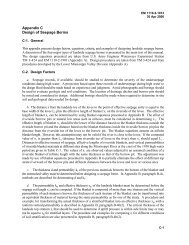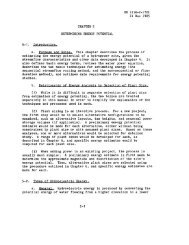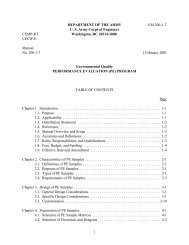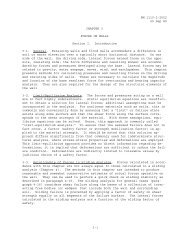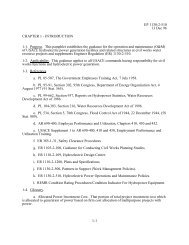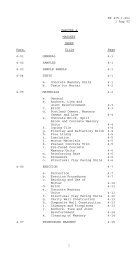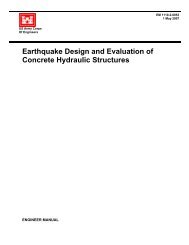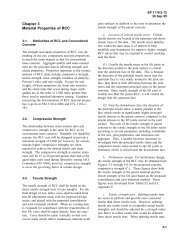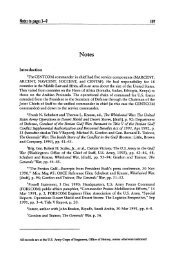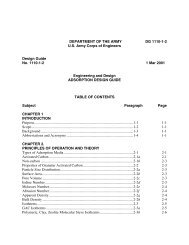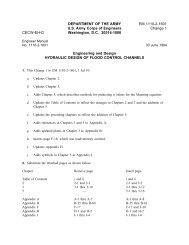em2901.chp:Corel VENTURA - Publications, US Army Corps of ...
em2901.chp:Corel VENTURA - Publications, US Army Corps of ...
em2901.chp:Corel VENTURA - Publications, US Army Corps of ...
You also want an ePaper? Increase the reach of your titles
YUMPU automatically turns print PDFs into web optimized ePapers that Google loves.
EM 1110-2-2702<br />
1 Jan 00<br />
3-18<br />
H = reservoir pool depth (to bottom <strong>of</strong> dam) on upstream or downstream side <strong>of</strong> the structure<br />
ac = maximum base acceleration <strong>of</strong> the dam due to the OBE (expressed as a fraction <strong>of</strong> gravitational<br />
acceleration)<br />
For load case 5 (paragraph 3-4.b(2)(e)), water is not on the structure, and E is due to mass inertia forces <strong>of</strong><br />
the structure, ice, and mud.<br />
where<br />
E M<br />
= ac<br />
W D, C,<br />
(3-4)<br />
WD,C,M = weight <strong>of</strong> the portion <strong>of</strong> the structure, ice, and mud that are supported by the member in<br />
question.<br />
(h) Wave load WA. Wave loads are site specific and should be determined in consultation with the<br />
project hydraulic engineer. Guidance on development <strong>of</strong> wave loading is provided in the Shore Protection<br />
Manual (1984).<br />
(i) Wind load W. Wind loads are site specific and should be calculated in accordance with ASCE<br />
(1995) but not more than 2.4 KPa (50 psf). Wind loads are small when compared to hydrostatic loads and<br />
only affect gate reactions when the gate is in an open position.<br />
(2) Load cases. Tainter gates shall be designed considering the strength requirements for each <strong>of</strong> the<br />
following load cases and corresponding load combinations. The most unfavorable effect on various gate<br />
components may occur when one or more <strong>of</strong> the loads in a particular load combination is equal to zero.<br />
Various conditions are described for the cases <strong>of</strong> gate in the closed position (load case 1), gate operating<br />
(load case 2 and load case 3), gate jammed (load case 4), and gate fully opened (load case 5). The<br />
operating machinery may include forces in each load case; however, these forces are treated as gate reactions<br />
in some cases. As a result, the load Q does not appear in some load cases (paragraph 3-4.b(2)(f)).<br />
(a) Load case 1: Gate closed. Load combinations for this load case (Equations 3-5, 3-6, and 3-7)<br />
apply when the gate is in the closed position.<br />
1.4 H + 1.2D + 1.6(C + M) + 1.2 Q<br />
1 2 (3-5)<br />
1.4 H 2<br />
1<br />
2 A<br />
2 I<br />
+ 1.2D + 1.6(C + M) + [ 1.2 Q or ( 1 . 2Q<br />
1.2W ) or ( 1.<br />
2Q<br />
k I) ]<br />
(3-6)<br />
1.2 H 3 + 1.2D + 1.6(C+ M) + 1.0E<br />
(3-7)<br />
1) Extreme pool condition. Equation 3-5 describes the condition where the maximum hydrostatic<br />
load H1 is applied, gravity loads D, C, and M exist, and the hydraulic cylinders exert the at-rest load Q2.<br />
(For gates with wire rope hoists, Q2 does not exist.) It is assumed that the likelihood <strong>of</strong> the simultaneous<br />
occurrence <strong>of</strong> H1 and WA or I or E is negligible.<br />
2) Operating pool condition. Equation 3-6 describes the condition for which the moderate hydrostatic<br />
load H2 acts in combination with Q1 or WA or I. Gravity loads D, C, and M always exist, and it is<br />
assumed that Q1, WA, and I will not occur at the same time. The load Q2 will likely always exist with W or




